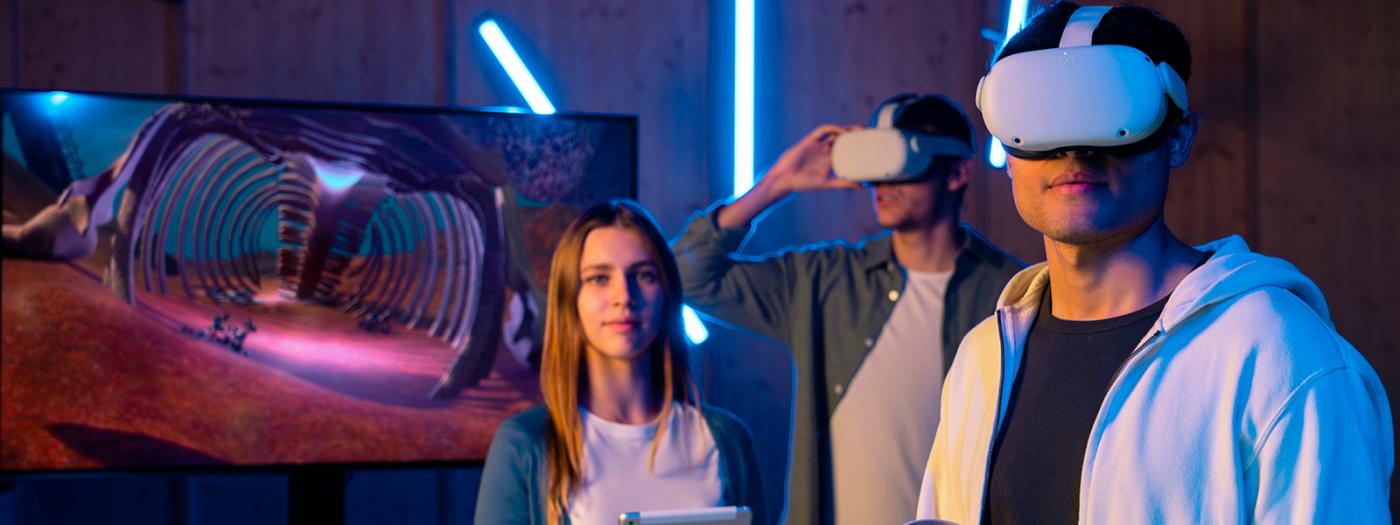Titular Professors
Learning Outcomes of this subject are:
LO.01 Know how to write the scripts for an audiovisual production
LO.02 Know how to write interactive scripts
LO.03 Saber creating a transmedia narrative
LO.04 Basic knowledge of how to act in front of the cameras
LO.05 Be able to correctly transmit the work done
1. Foundations of Audiovisual Narrative
Introduction to audiovisual narrative: language, codes, and structures.
Applications of audiovisual scriptwriting in film, advertising, animation, and videogames.
Visual and sound narrative: how framing, rhythm, and sound tell stories.
Formats and styles: fiction, documentary, music video, experimental, interactive.
2. References, Imaginary Worlds, and Semiotics
References and imaginary worlds: creating visual and narrative universes.
Study of references: analysis of key scenes (film, series, videogames).
Semiotics and the meaning of images: signs, symbols, and visual metaphors.
Character creation: archetypes, internal conflict, and narrative arc.
3. Planning and Camera Movement
Shot types: narrative and psychological function of framing.
Camera movements: pan, tracking shots, tilt, zoom, steadycam, drone.
Planning rules: 180° rule, continuity, raccord, and visual rhythm.
4. Lighting and Staging
Principles of narrative lighting: temperature, direction, and intensity.
Lighting schemes: three-point lighting, Rembrandt, backlight, expressionist lighting.
Types of lighting equipment: LED, tungsten, RGB panels, natural light.
Acting in front of the camera: presence, naturalness, and emotional coherence.
5. Types of Scripts and Storytelling Tools
Storyline, ripomatics, storyboard, animatic, literary script, and technical script.
Storytelling tools: the three-act structure.
Interactive and branching scripts: decisions, narrative routes, and user feedback in videogames.
6. Interactive Narrative and Narrative Videogame
Introduction to interactive and transmedia narrative.
Non-linear scriptwriting and branching narrative structures.
Adapting audiovisual storytelling to the language of videogames.
Narrative integration: cinematics, cutscenes, decisions, and player agency.
Short theoretical classes with audiovisual examples and discussion.
Practical workshops in scriptwriting, camera work, lighting, and acting.
Analysis of references.
Group work for audiovisual or interactive projects.
4 mandatory assignments throughout the course.
P1. Reference analysis ? 25%
P2. Script and storyboard ? 25%
P3. Narrative videogame ? 25%
P4. Videogame programming (based on P1) ? 25%
Extraordinary Resit (July)
Continuous assessment grades cannot be retaken.
Rules and Additional Notes
In cases of plagiarism, the university?s regulations will be applied. Plagiarism includes any work that uses third-party information, fully or partially, without proper citation.
All submitted materials must be original unless the assignment explicitly states otherwise.
On presentation day, all group members must be present for the assignment to be accepted.
If it is detected that a student has not participated in the work, they will receive a Fail ? Not Submitted (NP). The instructor may request an individual interview to verify knowledge.
Deadlines are strict.
Submissions must be uploaded to eStudy in the correct folder and in the correct format.
It is the student?s responsibility to ensure that the file is correctly uploaded, that it is the correct version, in the correct format, and that it opens without issues. Otherwise, the assignment will be graded as NP.
The course requires regular reading, writing, and presentation activities, as well as a minimum of 13 class attendances.
Field, S. (2005). El manual del guionista. Plot Ediciones.
McKee, R. (2010). El guion. Alba Editorial.
Gurney, J. (2015, 5 febrero). Luz y color (Colec. Espacio de Diseño). Anaya Multimedia.
Mateu-Mestre, M. (2020, 10 septiembre). Tinta: Dibujo y composición para narradores visuales (Colec. Espacio de Diseño). Anaya Multimedia.
Skolnick, E. (2014). Video Game Storytelling. Watson-Guptill.
Lieu, D. (s. f.). Derek Lieu [canal de YouTube]. Recuperado de https://www.youtube.com/c/dereklieu
Rickett, M. (2024, 27 noviembre). What is a logline? [Entrada de blog]. StudioBinder. Recuperado de https://www.studiobinder.com/blog/what-is-a-logline/
